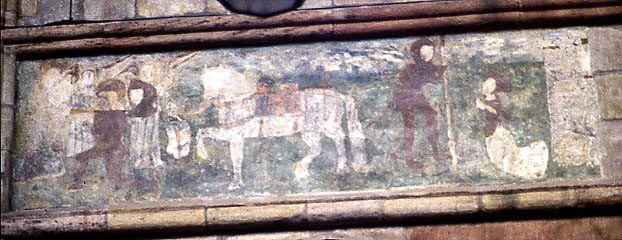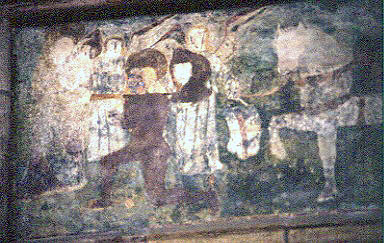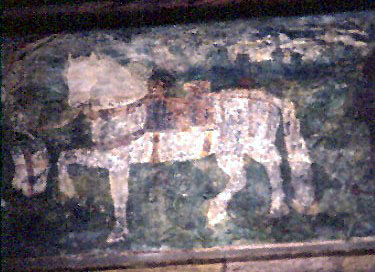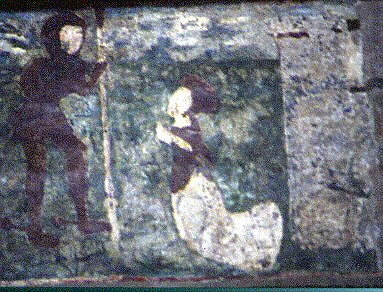Astbury, Cheshire (†Chester) Later C.15
St George dedicating himself to the Virgin

A rare English sighting of St George without the Dragon, but with some other very uncommon contextual details.¹ At the far left and shown left below, George kneels, accompanied by a priest in a white robe and a red-brown cowl, before an altar beside which the Virgin stands at the extreme left. She has almost disappeared, but something of two angels accompanying her, particularly their narrow, diagonally-angled wings, can still be seen. St George has laid aside his shield for this act of dedication, and it stands, its red cross still detectable, to the right of the priest.

In the center of the painting and shown at the right here below is George’s white horse, saddled and ready. The horizon(?) visible here may show buildings, but it is difficult to be sure.

The scene to the right (detail below left) has George standing with a lance, with a kneeling female figure who is almost certainly the the princess in his story, and who is about to become the Dragon’s next victim unless George intervenes. A structure to the right of the princess may be intended for a stone doorway or tower.

It may be that this painting is meant, unusually, to be read from right to left, and that this depiction of the kneeling princess is intended to show her entreating George’s help in the beginning, after which George prays for the assistance of Christ and the Virgin before the combat. On the other hand, the princess may be kneeling in gratitude before her victorious champion. There may once have been other scenes, including the Dragon, painted elsewhere on this north wall, but there is nothing else left now.
There are, however, many other interesting medieval features at Astbury, including a fine stained glass panel showing St Anne teaching the Virgin to read. The sculpted heads, especially those in the central aisle of the nave are superbly expressive (their expressions are, it must be said, exceptionally grave and serious – no amusing grotesques here). But this is the work of a remarkable craftsman creating images of what were obviously real people. (Click here for an example). The carved heads behind the altar are modern, but the medieval artist has clearly inspired the modern one.
Website for St Mary’s, Astbury
¹ St Anietus’ church, St Neot’s, Cornwall has a very full cycle of the Life of St George in early 16th century stained glass (I have not seen it)